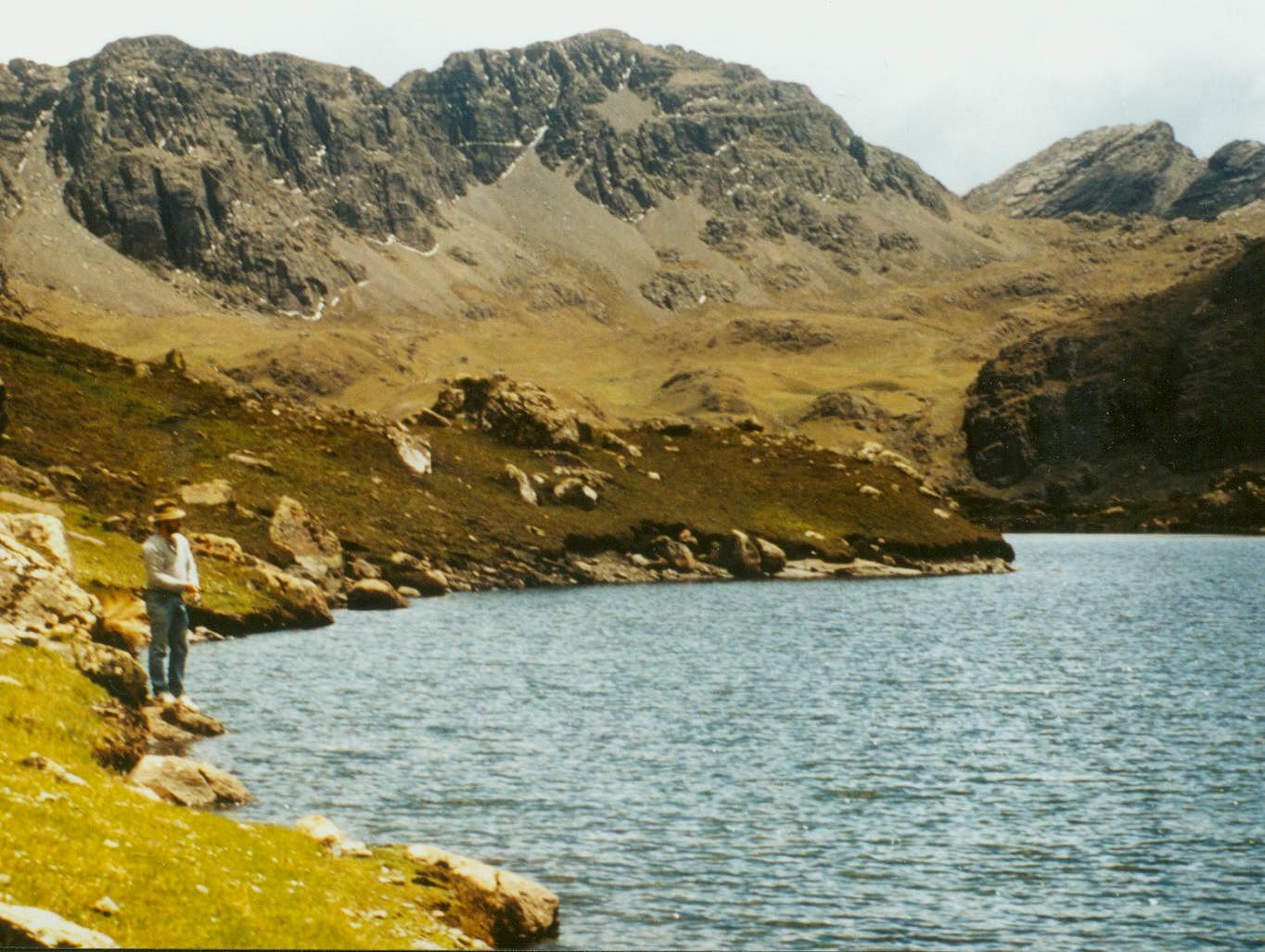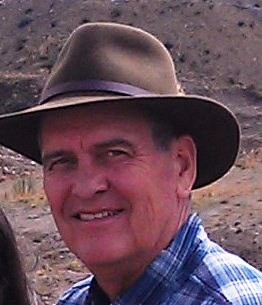What goes down
I learned the first rule about fishing for high altitude trout from Sir Isaac Newton: "What goes down, must come up."
Okay, Newton’s law of gravity doesn’t state it quite that way. But when fishing in the Andes, you best take gravity into account if you want to get there and home again.
Let’s say you want to fish a lake that lies a couple thousand vertical feet above the road where you parked your four-wheel drive truck. Yes, you best have four-wheel drive if you want to get there and home again. You park at 13,000 feet and start up a steep, stony trail. Within minutes your legs turn to lead and your lungs sputter and burn as if crammed with dry ice. What’s going on?
As you know, humans need oxygen. At 13,000 feet you don’t find much. I used to think it was because there is less oxygen in the air at these altitudes, but that’s not true. There is simply less air, period. The percentage of oxygen in the atmosphere remains constant, but the amount of atmosphere clinging to earth’s surface tapers off as you climb.
Keep in mind that you are climbing out of the parts of the earth where humans are meant to live and entering the part meant for llamas, condors and airplanes. These creatures are genetically designed for this, you are not. If you don’t take it easy, and sometimes if you do, you will fall ill with what scientists call hypobaropathy, and what we in the Andes call sorojchi.
Symptoms include pounding headache, debilitating fatigue, dizziness, chills, vomiting, diarrhea and fainting. Sorojchi is in the class of illnesses which, at its onset, makes you think you’re going to die. Soon, you wish you could. Believe me, I know. Been there, done that.
Sorojchi is ugliest when it attacks guests. Once we hosted a group of friends from the U.S. state of Ohio. They landed at El Alto, the world’s highest international airport. It sits atop the Altiplano, a flat plain encircled by snowcapped mountains that extends from Lake Titicaca to the Uyuni Salt Flats at an average elevation of, guess what, 13,000 feet.

The headaches, dizziness and chills commenced on the second day of their visit. Half of the group would require medical attention, including IVs to rehydrate their over-stressed circulatory systems. We thought we might lose one or two, but thank God, everyone survived.
The puzzling thing about sorojchi is its unpredictability. Of our group of friends, it struck hardest a couple in their 20s and a vigorous hunter-fisherman. This man lapsed into unconsciousness and later could recall nothing of his first day on the Altiplano. In contrast, a roly-poly retired pastor in his mid-70s breezed through the 10 days with ne’er so much as a hiccup, treating us to an endless stream of corny jokes the whole time.
On another occasion, a friend from New York visited us for six weeks in Cochabamba, a city nestled in a valley at a more reasonable 8,500 feet. During her stay, and after she had had plenty of time to acclimate, we visited the Altiplano. I assumed our friend could handle the altitude. After all, she was a regular at her New York gym and even competed in the occasional 10K run.
I was wrong. Sorojchi struck with such vengeance that she lapsed into a paralyzed stupor, shivering violently under the heavy wool blankets that we piled on in a vain attempt to revive her. While we waited for help, I mentally composed a telegram (this was in the days before faxes and email) to break the news of her untimely death as gently as possible to her husband back home. Thankfully the doctor arrived in time and started an IV, so I never had to send the telegram.
Sorojchi is named for Cerro Soroche, a 15,000-foot peak in Ecuador. Get the connection? Consider it a friendly warning from the natives. Speaking of warnings, I understand small aircraft pilots are required by law to break out oxygen masks once they reach 15,000 feet. This is to prevent passengers from blacking out, which may require a doctor. It is also to prevent the pilot from blacking out, which may require an undertaker.
If you catch Sorojchi where there is no doctor, here are three things you can do.
-
Breathe.
-
When you start to feel asphyxiation coming on, keep breathing.
-
Should you suffer a pounding headache, become disoriented or immobile, develop uncontrollable shivers, lose bowel control or pass out, keep breathing.
Follow these simple steps and chances of survival are good.
By the way, do not fall into the devil’s trap of thinking you can avoid Sorojchi by simply fishing a lake below the spot where you parked your four-wheel drive. Sure, fishermen don’t typically fall ill while climbing downhill, especially on a fine morning with a good breakfast in your belly and the sun on your shoulders. But this is exactly where Newton’s law comes into play (see paragraph one above). In this scenario, Sorojchi will likely hit you in the afternoon when you’re climbing back up the stony trail all worn out from trout stalking, when your blood sugar is zero and the warm sun has turned into a freezing drizzle. Not fun.

So, what does this have to do with fishers of men? (See subtitle above). Just this, if you’re going to fish in the Andes, remember that stamina is essential. You can’t predict when sorojchi will strike. All you can do is keep breathing.
When Jesus met Peter, James and John on the beach at Galilea and invited these professional fishermen to follow him, the Bible says “they immediately left their nets and followed him.”
Why did they do that? I confess I don’t have a clue. I mean, it would cost them their very lives. Almost half of them, like their Master, would someday die on a cross. One or two others were beheaded. The rest were clubbed to death or run through with spears.
Nevertheless, once they made the decision to become fishers of men, these fellows never looked back. They spent every day of the next three years doing life with Jesus, through good times and bad, fame and disgrace, poverty and abundance, right up to the bitter end at Calvary.
Oops, did I say end? Actually that was just the beginning. After his death, Jesus came back and showed himself to them. After all, they were his best friends on earth. He was anxious for them to know the true ending to the story.
For 40 days after that, he spent time with them explaining his death and resurrection, that this had been planned long ago as the way mankind was to regain paradise lost. Then he commissioned them to spread the word to the ends of the earth. And they did, even though it would cost them painful death.
How did they find the stamina to do that? I think it boils down to trust. These guys seem to have trusted Jesus immediately, completely and audaciously. Whether it was his honest face or penetrating gaze or authority to command half a ton of fish to swim into their nets, Jesus inspired trust.
Things have not changed in the intervening centuries when it comes to following Jesus. It still takes stamina. So if you decide to follow Jesus, here are three things you can do.
- Trust.
- When you have second thoughts and are tempted to turn back, keep trusting.
- Should you lose your job and be forced into bankruptcy, or suffer the betrayal of a close friend, or a divorce, or a death in the family, or contract a terminal illness, keep trusting.
Follow these simple steps and you will survive this life and thrive in the life hereafter.
As one famous scientist put it, “We must believe therefore in one Lord Jesus Christ, that we may behave ourselves obediently towards him as his subjects.” - Sir Isaac Newton.
Next time: How to find them.

